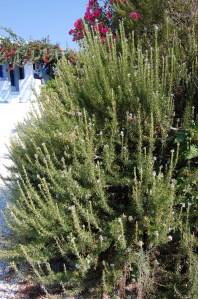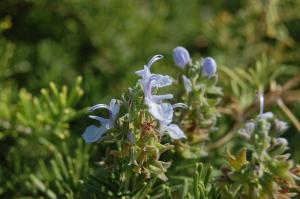Position: Sunny position

Rosmarinus officinalis (02/09/2011, Koufonisi, Greece)
Soil: Friable, free draining loam soil
Flowering period: Summer
Eventual Height: 1.5m
Eventual Spread: 1m
Hardiness: USDA Zones 7a-10b
Family: Lamiaceae
Rosmarinus officinalis is an evergreen woody, perennial herb with fragrant, needle like leaves. It’s evergreen leaves are 2-4cm long and 2-5mm broad, green above and white below with dense short wooly hair. The hermaphrodite flowers are blue flowers, some have pink or white but they are more commonly found in Europe. These are followed by a fruit which consists of a dry nut which is comprised of four sections.
R. officinalis, commonly also known as Rosemary, is native to the Mediterranean region. R.officinalis has been cultivated as a herb in Britian since at least 1375. This plant was named by the 18th century naturalist and founding taxonomist Carolus Linnaeus, it has not undergone much taxonomical change since. Rosemary is associated with with the Greek goddess Aphrodite and the Virgin Mary.
The name Rosmarinus is derived from the Latin ros meaning ‘dew’ and marinus meaning ‘sea’ referring to the plants ability to accumulate all the water it requires from the humidity from the sea. Officinalis is derived from the Latin meaning ‘of the shop’ referring to the historic sale of this herb.

Rosmarinus officinalis flower (02/09/2011, Koufonisi, Greece)
The landscape architect may find this shrub suitable for use in arid areas as it can survive drought conditions, particularly in a Mediterranean climate. This plant forms an effective informal hedge which is fragrant when brushed up against. It is suitable for planting in maritime locations.
This plant prefers sandy to loamy soils and will tolerate any soil pH. It will tolerate very alkaline soils. This plant will not tolerate water-logging.
Ecologically this evergreen shrub attracts honey bees, bumble bees and butterflies
Maintenance: Requires little to no maintenance. This plant may be pruned any time of year.




